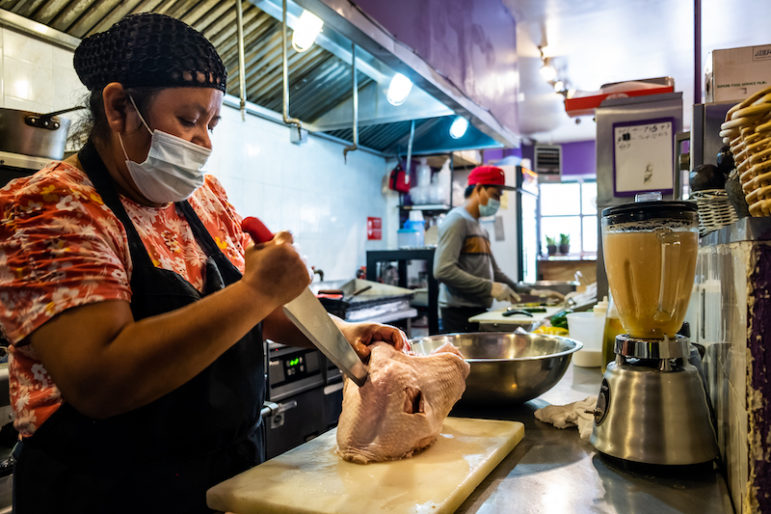Nationally, Latinos represent 18 percent of the nation’s workforce, but they are overrepresented in industries that lost thousands of jobs as a result of the economic crisis caused by the pandemic.

Adi Talwar
Natalia Méndez co-owner of La Morada, a restaurant in the South Bronx. Despite experiencing financial problems due to the COVID-19 pandemic, the team at La Morada organizes free meals for people in need.This article originally appeared in Spanish.
Before the pandemic, life for many Latinos in New York was not easy: “It has never been easy for us. And it’s not that we’re not feeling the impact now, but we’re holding out longer,” says Natalia Méndez, chef and co-owner of La Morada restaurant in the South Bronx.
La Morada was one of the thousands of restaurants forced to close in mid-March when the pandemic hit New York City. According to Méndez, La Morada sold about $80 the last week it operated in March. Nationally, Latinos are still seeing higher unemployment, and locally, in both New York State and the city, unemployment remains high.
Latinos accounted for 18 percent of total employment nationwide but were substantially overrepresented in several industries, six in particular: landscaping services with 43 percent of the workforce being Latino, followed by food manufacturing (30 percent), construction (30 percent), room and board services (27 percent), cab and limousine services (24 percent), and clothing stores (24 percent).
Like millions of undocumented immigrants in the country, Méndez did not receive the checks that came from the federal government, nor did she receive unemployment benefits, and her restaurant did not qualify for the Paycheck Protection Program (PPP).
“I wish they had given me something so I could have helped more,” says Méndez, who acknowledges that the biggest support has come from the community itself, from hundreds of volunteers, donations, other restaurants, and community organizations.
“The idea came from five people, my family, but the effort has come from the community,” acknowledges Méndez. The idea to reopen the restaurant in April and turn it into a soup kitchen came from one of his daughters, who told her that being quiet and doing nothing in difficult times was not in her family’s nature. La Morada opened its doors during the Great Recession in 2009 and has been a place of civil disobedience, community activism and immigrant rights activism.
“We thought it [the pandemic] was only going to last a week or a couple of weeks, but look where we are,” says Méndez. They started giving out hot soup; the food was gone in an hour. Then they made food to serve 100, 200, 400, 600 people reaching the threshold of almost a thousand meals a day, about 5,000 meals a week.
Concentrated in hard-hit sectors
According to the United States Bureau of Labor Statistics, in New York state the five industries that employ the most Latinos also suffered heavy job losses. The highest percentage of Latinos in the state work in the education and health services sector, 23.3 percent.
The next largest share of employed Latinos is in leisure and hospitality industries, 13 percent, followed by Professional and business services, 12.4 percent, wholesale and retail trade, 10.9 percent, and construction, 10.2 percent.
Contrary to what this trend shows, La Morada restaurant did not fire anyone because everyone who works there is family. No one could be fired. Parents, children, nephews and aunts work there. They were 10 before the pandemic and they are still 10 now.
According to Bruce Bergman, regional economist at the US Bureau of Labor Statistics, “employment declines were particularly steep in leisure and hospitality, and that sector had the largest loss of jobs locally and nationally. The latest estimates from our Current Employment Statistics program show a New York metropolitan area job loss in this sector of more than 400,000 jobs for the year ending in July, with New York City accounting for a loss of 250,000 workers.”
According to the U.S. Bureau of Labor Statistics, the leisure and hospitality industries lost the most jobs between July 2019 and July 2020 in the New York metropolitan area with a reduction of 439,800 jobs, a decline of 43.9 percent. Nationally, these industries declined 24.2 percent.
The second-largest contraction, 16.5 percent, was in the “other services” sector, which includes repair and maintenance, personal and laundry services, religious organizations, grantmaking, civic, professional and private households.
Education and health, industries where Latino labor concentrates, lost more than 150,000 jobs each since July 2019 in New York and New Jersey. Professional and business services, the third-largest source of Latino employment, saw the sharpest drop: 185,000 jobs lost.
According to the Census Bureau’s Household Pulse Survey, Latino households in New York State reported the highest percentage of people who did not work for 12 weeks (April 23-July 21). This weekly measurement fluctuates from 51.2 percent to 70.9 percent.
During this same period, Latino households not only reported high rates of joblessness but also reported the most lost income in New York State at rates ranging from 64.7 percent to 75.4 percent.
As Jaclyn Kelly, director of the New York City Labor Market Information Service (LMIS) at the Center for Urban Research at the Graduate Center at CUNY points out, these figures presented in this way do not show the trends and evolution of the disproportionate impact of the crisis on the Latino community. “The impacts described above seemed to begin to diminish in mid-May,” Kelly wrote by email, “but began to rise again in mid-June.”
In the city, the same story
The same four sectors with large job losses for Latinos in New York State are also the four sectors with the highest levels of unemployment in the city: accommodations and food services, professional and business services, specifically in the administrative and support services and waste management sub-sector, retail, and health care—the industry that employs the largest number of Latinos in the city.
According to data collected by the LMIS, from the start of the pandemic in March through July 2020, the accommodations and food services saw the largest drop in jobs, 147,700. Comparing the one-year change in jobs from July 2019 to July 2020, 184,500 jobs were lost in this sector.
A restaurant like La Morada needs $10,000 a week to sustain itself and is now collecting just under $2,500 a week. “We’ve recovered 25 percent, but that’s not profit. We are stretching the budget. For example, we haven’t been able to buy shoes,” says Méndez.
To sustain the restaurant, Méndez is paying for the most basic and necessary things: water, electricity, gas, and supplies that run out like oil and salt. Since March they have not paid rent. Since March none of them receive a salary, “but we are used to this. For the first five years we didn’t have a salary,” says Méndez.
Unfortunately, as confirmed by Bergman, the U.S. Bureau of Labor Statistics does not have detailed information at this time that specifically says how many Latinos lost their jobs in the industries that were hardest hit at the local or state level. “The geographic detail that we do have for employed Hispanic or Latino workers by state and industry, are available only on an annual basis.”
And in the Bronx
Unemployment has hit not only the city’s industries where there were the largest numbers of Latino workers but has also hit the Bronx, the city’s county with the highest concentration of Latinos, harshly. According to the New York State Department of Labor, nearly one in four people in the Bronx is unemployed.
The Bronx had the highest unemployment rate in the entire state in July, 24.9 percent, almost five points above the city’s unemployment rate of 20 percent, and almost nine points above the state’s rate of 16 percent.
“I am not surprised by this unemployment report, it is a well-known secret,” says Lisa Sorin, president of the Bronx Chamber of Commerce. “We estimate that 45 percent of businesses will be lost,” she adds. Some 609,876 Latinos live in Bronx County, representing 61.3 percent of the county’s workforce.
“The Bronx has always been behind and they are leaving it behind again. Less than 1 percent of New York City’s small business loans for COVID-19 went to the Bronx,” says Sorin.
Of the nearly 24,000 businesses in the county, “at the last PPP count, only 9,000 loans came to the Bronx,” says Sorin. That means 37.5 percent of the businesses received these funds.
“We directly helped about 120 Latino businesses apply for PPP,” Sorin adds.
“Latino restaurants are surviving because of the cash economy, or because of the community or neighbors, or through GoFundMe campaigns,” says Michael Brady, executive director of the 3rd Avenue Business Improvement District (BID).
Sorin explained that many of the businesses in the Bronx are family businesses and in addition to restaurants, the sectors that saw large reductions were small retailers, independent phone stores, beauty stores, and small clothing stores.
Even within the Bronx there are areas that have seen greater economic impacts than others. For example, Little Italy has held up and is now thriving. On the other hand, one of the areas most affected is the restaurants and bars around Yankee Stadium, the businesses on River Road, the White Plains and East Tremont area, the East 138th Street area, and some areas on Fordham Road.
“Our needs are different from other boroughs,” Sorin says, “and more attention is needed in areas where there is no business improvement district (BID).”
One idea Brady is proposing is the creation of a mechanism so that businesses can access loans from public funds. “Waiting for the federal government is terrible; the Trump administration has sent a clear message that there is no help coming.”
“During all this time we realized that we don’t need millions or a legal residence to help,” says Méndez. “We’ve been able to help, without thinking about whether we’re going to win or lose. We went out to satisfy the community and we are proud of it.”
In the last few weeks, La Morada has been handing out about 400 to 600 meals at lunchtime. Méndez recalls that when they decided to reopen the restaurant her husband, Antonio Saavedra, said, “I die fighting, I don’t die on my knees.”
If you wish to donate to La Morada, you can do it on its GoFundMe page.








